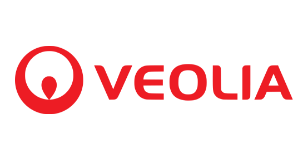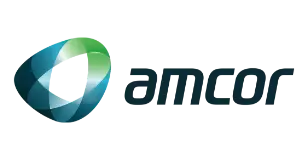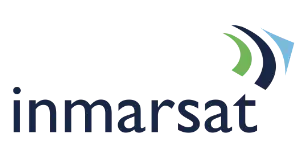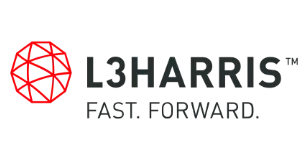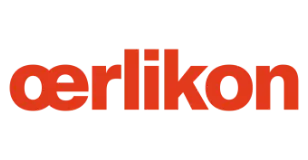
Global 5G Satellite Communication Market Research Report: Forecast (2025-2030)
5G Satellite Communication Market - By Solutions (Backhaul and Tower Feed, Trunking and Head End Feed, Communication-On-the-Move, Hybrid Multiplay), By Orbit ((Geosynchronous Earth... Orbit (Large, Heavy, Extra Heavy), Medium Earth Orbit (Medium,Intermediate), Low Earth Orbit (Small, Mini, Pico, Nano, Micro) Others)), By End Users ((Defense & Government, Aviation, Transportation & Logistics, Consumer Electronics, Heavy Industries (Construction & Mining), Energy & Utilities (Oil & Gas, Utilities (Smart Grid)), Others (Smart Cities, Banking & Retail, Healthcare, Media & Entertainment)),and others. Read more
- ICT & Electronics
- Sep 2025
- Pages 196
- Report Format: PDF, Excel, PPT
Global 5G Satellite Communication Market
Projected 15.05% CAGR from 2025 to 2030
Study Period
2025-2030
Market Size (2025)
USD 5.05 Billion
Market Size (2030)
USD 10.18 Billion
Largest Region
North America
Projected CAGR
15.05%
Leading Segments
By End User: Defense & Government
Market Insights & Analysis: Global 5G Satellite Communication Market (2025-30):
The Global 5G Satellite Communication Market size is valued at around USD 5.05 billion in 2025 and is projected to reach USD 10.18 billion by 2030. Along with this, the market is estimated to grow at a CAGR of around 15.05% during the forecast period, i.e., 2025-30. The major factor driving market growth is high-speed connectivity, low latency, and seamless connectivity coverage across a wider geographic area. One key driver is the overwhelming growth of data-intensive applications such as autonomous vehicles, smart cities, and IoT ecosystems that require seamless high-speed connectivity in both urban and remote environments. Traditional Terrestrial networks, which often face coverage issues, are thus driving demand for satellite-based 5G solutions to enable greater connectivity.
Moreover, the growing deployment of low Earth orbit (LEO) satellite constellations by companies such as SpaceX and OneWeb provides a way to decrease latency and increase bandwidth, which will be helpful for real-time applications for 5G satellite communications. For instance, SpaceX's Starlink has already demonstrated internet connectivity rates above 100 Mbps in underserved areas, showcasing the transformative nature of the technology.
Furthermore, rising demand for continuous connectivity in the maritime, aviation, and defense sectors. airlines are deploying satellite-supported 5G networks to provide full connectivity during flights, while defense organizations are using this technology for machine-to-machine communications and high-speed communications in rugged environments. This demonstrates a shift towards mission-critical applications needing low-latency, high-reliability networks. In addition, the COVID-19 pandemic further increased the need for connectivity in distant and rural areas. Travel restrictions, social distancing, and the shift to study/work from home all reinforced the urgent move to provide increasingly faster and higher virtual connectivity in the transnational and rural areas of the world.
Global 5G Satellite Communication Market Scope:
| Category | Segments |
|---|---|
| By Solutions | Backhaul and Tower Feed, Trunking and Head End Feed, Communication-On-the-Move, Hybrid Multiplay |
| By Orbit | Geosynchronous Earth Orbit (Large, Heavy, Extra Heavy), Medium Earth Orbit (Medium,Intermediate), Low Earth Orbit (Small, Mini, Pico, Nano, Micro) Others |
| By End Users | Defense & Government, Aviation, Transportation & Logistics, Consumer Electronics, Heavy Industries (Construction & Mining), Energy & Utilities (Oil & Gas, Utilities (Smart Grid)), Others (Smart Cities, Banking & Retail, Healthcare, Media & Entertainment |
Global 5G Satellite Communication Market Driver:
Rising Demand for High-Speed & Reliable Global Connectivity – The worldwide 5G satellite communication industry expands because remote areas need fast internet access with minimal delays, while traditional network expansion remains economically unfeasible. The increasing deployment of data-intensive technologies, including autonomous vehicles, telemedicine systems, and IoT-enabled infrastructure, will drive up bandwidth needs and network stability requirements across all areas, including those with poor connectivity. Satellite-based 5G networks serve as the only solution for these applications because they provide both real-time data transmission and continuous network connectivity.
For instance, the aviation and maritime industries rely on satellite-based 5G technology to maintain communication, which extends past the range of traditional terrestrial networks. SpaceX Starlink, along with other companies, continues to launch LEO satellite constellations, which reduces latency and expands network capacity to create worldwide high-speed internet availability. Moreover, Telecom operators together with satellite manufacturers and service providers need to develop satellite-based 5G solutions because these technologies will help them discover new market opportunities and deliver superior services while reaching customers in areas that used to lack network access.
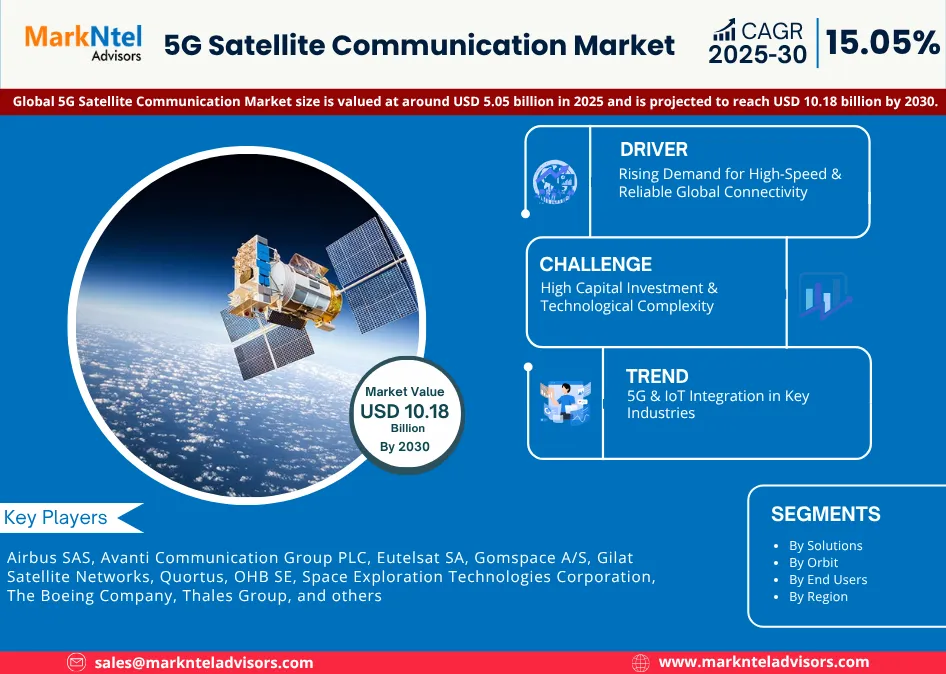
Global 5G Satellite Communication Market Challenge:
High Capital Investment & Technological Complexity – One of the primary barriers for the growth & expansion of the 5G Satellite Communication Industry is the financial investment and technological complexity to support the ability to deploy large numbers of 5G-enabled satellite constellations. The costs related to deploying a truly global service exceed USD1.13 billion in upfront costs for satellite manufacturing, launch vehicles, ground stations, and sophisticated communication technologies. For instance, SpaceX’s Starlink has decided to invest tens of billions of dollars into the development and launch of its low Earth orbit (LEO) satellites before it breaks even on its upfront investment, illustrating the cost burden that is required to attract investment into a new global 5G satellite communications network.
Commercially, technical hurdles also exist where latency needs to be reduced, differences in terrestrial 5G and satellite networks need to be integrated, and effective spectrum management needs to be developed, amplifying the complexity of deploying these systems on a global scale. Because of the costs and complexities, the timeline to deployment is lengthened, and only large, well-capitalized, and financed participants may engage in the commercial process. As the complexity increases, operators may experience longer payback periods, which slows the pace of adoption more broadly, and possibly restricts limited competitive price advantages in a new competitive 5G satellite communications market in which only a few well-capitalized firms participate.
Global 5G Satellite Communication Market Trend:
5G & IoT Integration in Key Industries - A major trend in the Global 5G Satellite Communications Market emerges from the increasing adoption of 5G satellite networks for industrial Internet of Things (IoT) applications. The growing digital transformation of aviation, defense, logistics, smart cities, and agriculture requires better real-time connectivity with minimal delays and stable connections. The integration of satellite technology with 5G networks enables all IoT devices to send vital data across the world, including remote locations without any terrestrial network coverage. For example, the agricultural sector uses 5G technology together with satellite systems to link ground-based IoT sensors, which track soil, water, and crop status for better yield production and resource management. The logistics sector, transportation operations, needs satellite 5G-IoT connectivity to track their fleet in real-time for predicting maintenance requirements. The emerging market trend drives telecommunications operators, service providers, and industrial applications to adopt satellite-enabled 5G and IoT solutions, which will boost market expansion and create advanced data-driven industrial applications across the world.
Global 5G Satellite Communication Market (2025-30): Segmentation Analysis
The Global 5G Satellite Communication Market study of MarkNtel Advisors evaluates & highlights the major trends and influencing factors in each segment. It includes predictions for the period 2025–30 at the global level. Based on the analysis, the market has been further classified as:
Based on Orbit:
- Geosynchronous Earth Orbit (Large, Heavy, Extra Heavy)
- Medium Earth Orbit (Medium, Intermediate)
- Low Earth Orbit (Small, Mini, Pico, Nano, Micro)
- Others
Based on the orbit, the Low Earth Orbit (LEO) segment holds the largest share of the 5G Global Satellite Communication Market, around 54%. This is due to their ability to provide low-latency, high-speed, and global coverage. LEO satellites function between 500 and 2,000 kilometers above Earth, which produces minimal signal delays compared to geostationary satellites because they enable fast data transmission for autonomous vehicles, telemedicine, and industrial IoT systems.
The fast deployment of LEO satellite constellations by OneWeb and other companies for global broadband access has improved network stability and expanded service availability to distant and unconnected areas. LEO satellites enable flexible network capacity scaling through their technology, which allows telecom operators and service providers to modify their network capacity based on customer requirements. The expansion of this market segment drives telecom operators, satellite manufacturers, and solution providers to build advanced LEO-based infrastructure, which enables fast network access with minimal delay. The commercial 5G satellite market will continue to favor LEO satellites for its preferred operational orbit across the globe. Therefore, Low Earth Orbit (LEO) is anticipated to augment the market size & volume during the forecast period as well.
Based on End User:
- Defense & Government
- Aviation
- Transportation & Logistics
- Consumer Electronics
- Heavy Industries (Construction & Mining)
- Energy & Utilities (Oil & Gas, Utilities (Smart Grid))
- Others (Smart Cities, Banking & Retail, Healthcare, Media & Entertainment)
Based on end user, the Defense & Government sector holds the largest market share. This is due to the secure and reliable real-time communication networks function as vital operational requirements for this sector. The military, along with national security agencies and government organizations, depend on satellite-based 5G networks to sustain continuous communication in areas that lack terrestrial networks or where such networks face security threats.
For instance, the U.S. Department of Defense (DoD) employs 5G satellite technology for battlefield communications and intelligence operations and real-time surveillance activities. The networks provide defense personnel with fast data transfer and protected communication systems, which help them make crucial operational decisions. Satellite 5G technology expansion in this field generates financial backing from telecom operators, satellite manufacturers, and service providers who work together to create specialized, secure satellite systems that meet government requirements. The Defense & Government sector establishes a continuous market for 5G satellite services through its operations while driving technological progress, which ultimately augments the size & volume of the 5G Satellite Communication Industry.
Global 5G Satellite Communication Market (2025-30): Regional Projections
Geographically, the Global 5G Satellite Communication Market expands across:
- North America
- South America
- Europe
- The Middle East & Africa
- Asia-Pacific
Regionally, North America holds the major share of the market, around 40%. This region leads because of its modern space facilities, superior technological systems, and its private and public sector backing. For instance, the United States and Canada receive satellite broadband and 5G backhaul services from Hughes Network Systems, which allows them to provide high-speed internet access to distant locations.
- Amazon's Project Kuiper will launch more than 3,200 LEO satellites to spread broadband and enterprise 5G services throughout North America to keep the region at the forefront of satellite network advancement.
The defense and aerospace sectors further contribute by adopting satellite-enabled 5G for secure, mission-critical communications. The combination of private funding, government backing, and technological knowledge has made North America the leading center for 5G satellite development worldwide. The region achieves superior market competitiveness through telecom operators and service providers who use multiple satellite solutions together with extensive deployment methods to provide stable, low-latency connectivity.
Global 5G Satellite Communication Industry Recent Development:
- June 2025: Avanti Communications Group PLC has entered into a multi-year partnership with Orange Africa and the Middle East to provide low Earth orbit (LEO) satellite communications via OneWeb's constellation. This collaboration aims to offer high-throughput, low-latency services to enterprise and government customers, particularly in remote or underserved regions.
- February 2025: Gilat Satellite Networks launched a Defense Division to meet rising government and military SATCOM demands, appointing Gilad Landsberg as President. The division focuses on secure, rapid-deployment communications for the U.S. DoD, NATO, and allies. Gilat Defense showcased its innovative, high-redundancy connectivity solutions at Satellite 2025 for modern defense operations.
Gain a Competitive Edge with Our Global 5G Satellite Communication Market Report
- Global 5G Satellite Communication Market Report by MarkNtel Advisors provides a detailed & thorough analysis of market size & market share, growth rate, competitive landscape, and key players. This comprehensive analysis helps businesses gain a holistic understanding of market dynamics & make informed decisions.
- This report also highlights current market trends & future projections, allowing businesses to identify emerging opportunities & potential challenges. By understanding market forecasts, companies can align their strategies & stay ahead of the competition.
- Global 5G Satellite Communication Market Report aids in assessing & mitigating risks associated with entering or operating in the market. By understanding market dynamics, regulatory frameworks, and potential challenges, businesses can develop strategies to minimize risks & optimize their operations.
*Reports Delivery Format - Market research studies from MarkNtel Advisors are offered in PDF, Excel and PowerPoint formats. Within 24 hours of the payment being successfully received, the report will be sent to your email address.
Frequently Asked Questions
- Introduction
- Product Definition
- Research Process
- Assumptions
- Market Segmentation
- Preface
- Executive Summary
- Impact of COVID-19 on 5G Satellite Communication Market
- Global 5G Satellite Communication Evolution
- Global 5G Satellite Communication Technology Timeline
- Global 5G Satellite Communication Roll out Models & Roll Out Timeline
- Global 5G Satellite Communication Market Dynamics
- Drivers
- Challenges
- Impact Analysis
- Global 5G Satellite Communication Opportunity & Hotspots
- Global 5G Satellite Communication Value Chain Analysis
- Global 5G Satellite Communication Trends & Insights
- Global 5G Satellite Communication Policies and Regulatory Landscape
- Global 5G Satellite Communication Technology Intellectual Property Rights Analysis
- Global 5G Satellite Communication Market, 2020-2030F
- Market Size & Analysis
- By Revenues
- Market Share & Analysis
- By Solutions
- Backhaul and Tower Feed
- Trunking and Head End Feed
- Communication-On-the-Move
- Hybrid Multiplay
- By Orbit
- Geosynchronous Earth Orbit (Large, Heavy, Extra Heavy)
- Medium Earth Orbit (Medium,Intermediate)
- Low Earth Orbit (Small, Mini, Pico, Nano, Micro)
- Others
- By End Users
- Defense & Government
- Aviation
- Transportation & Logistics
- Consumer Electronics
- Heavy Industries (Construction & Mining)
- Energy & Utilities (Oil & Gas, Utilities (Smart Grid))
- Others (Smart Cities, Banking & Retail, Healthcare, Media & Entertainment)
- By Region
- Asia-Pacific
- North America
- Europe
- Rest-of-the-World
- By Competition
- Key Alliances
- By Solutions
- Market Size & Analysis
- North America 5G Satellite Communication Market, 2020-2030F
- Market Size & Analysis
- By Revenues
- Market Share & Analysis
- By Country
- The US
- Canada
- Mexico
- By Country
- Market Size & Analysis
- Europe 5G Satellite Communication Market, 2020-2030F
- Market Size & Analysis
- By Revenues
- Market Share & Analysis
- By Country
- The UK
- Germany
- France
- Russia
- Rest of Europe
- By Country
- Market Size & Analysis
- Asia Pacific 5G Satellite Communication Market, 2020-2030F
- Market Size & Analysis
- By Revenues
- Market Share & Analysis
- By Country
- China
- Japan
- South Korea
- India
- Rest of Asia Pacific
- By Country
- Market Size & Analysis
- Company Profiles
- Airbus SAS
- Avanti Communication Group PLC
- Eutelsat SA
- Gomspace A/S
- Gilat Satellite Networks
- Quortus
- OHB SE
- Space Exploration Technologies Corporation
- The Boeing Company
- Thales Group
- Others
- Disclaimer
MarkNtel Advisors follows a robust and iterative research methodology designed to ensure maximum accuracy and minimize deviation in market estimates and forecasts. Our approach combines both bottom-up and top-down techniques to effectively segment and quantify various aspects of the market. A consistent feature across all our research reports is data triangulation, which examines the market from three distinct perspectives to validate findings. Key components of our research process include:
1. Scope & Research Design At the outset, MarkNtel Advisors define the research objectives and formulate pertinent questions. This phase involves determining the type of research—qualitative or quantitative—and designing a methodology that outlines data collection methods, target demographics, and analytical tools. They also establish timelines and budgets to ensure the research aligns with client goals.
2. Sample Selection and Data Collection In this stage, the firm identifies the target audience and determines the appropriate sample size to ensure representativeness. They employ various sampling methods, such as random or stratified sampling, based on the research objectives. Data collection is carried out using tools like surveys, interviews, and observations, ensuring the gathered data is reliable and relevant.
3. Data Analysis and Validation Once data is collected, MarkNtel Advisors undertake a rigorous analysis process. This includes cleaning the data to remove inconsistencies, employing statistical software for quantitative analysis, and thematic analysis for qualitative data. Validation steps are taken to ensure the accuracy and reliability of the findings, minimizing biases and errors.
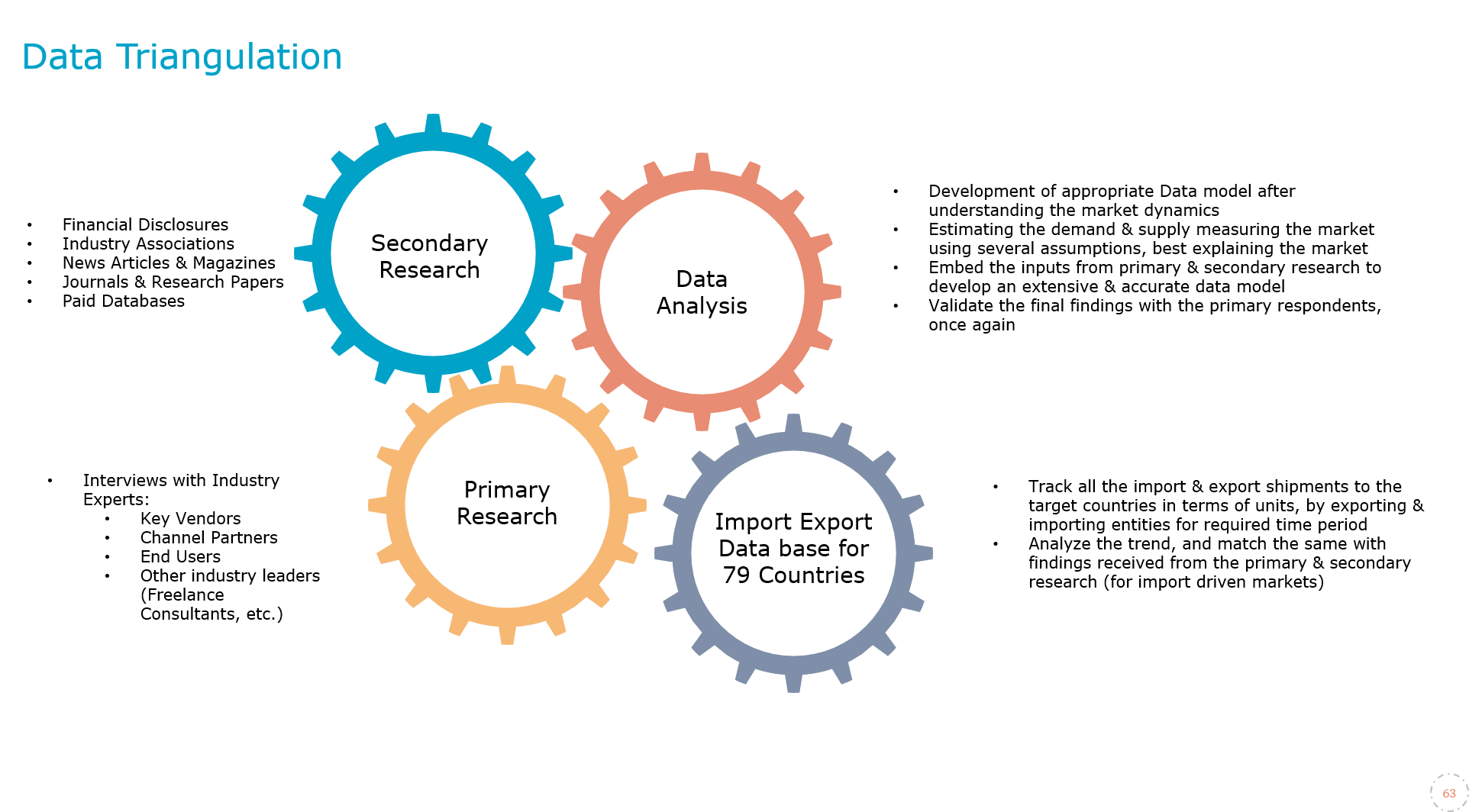
4. Data Forecast and FinalizationThe final phase involves forecasting future market trends based on the analyzed data. MarkNtel Advisors utilize predictive modeling and time series analysis to anticipate market behaviors. The insights are then compiled into comprehensive reports, featuring visual aids like charts and graphs, and include strategic recommendations to inform client decision-making

